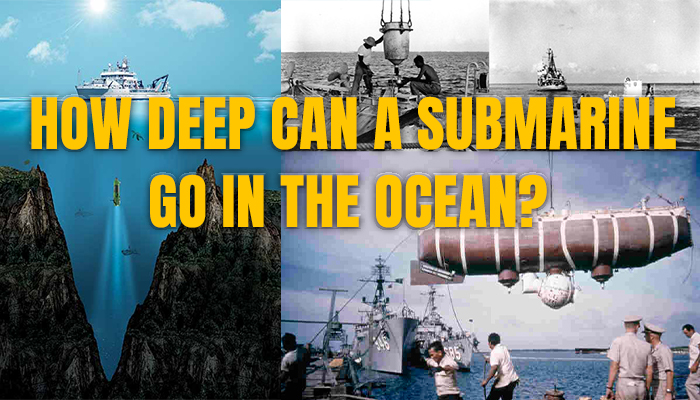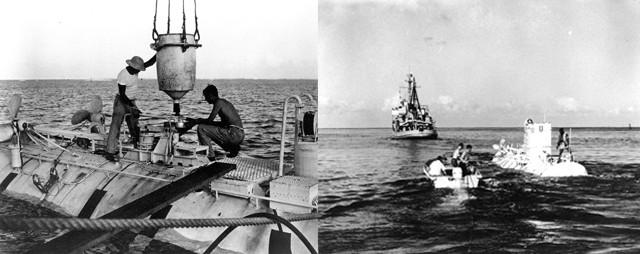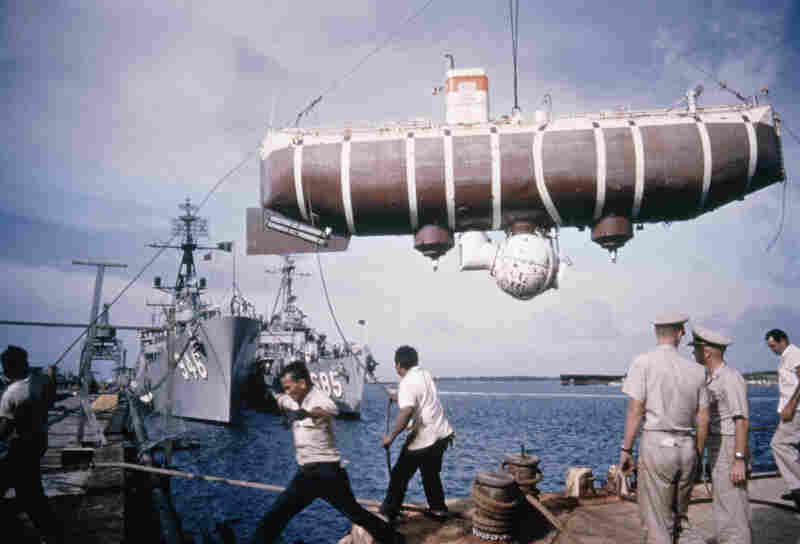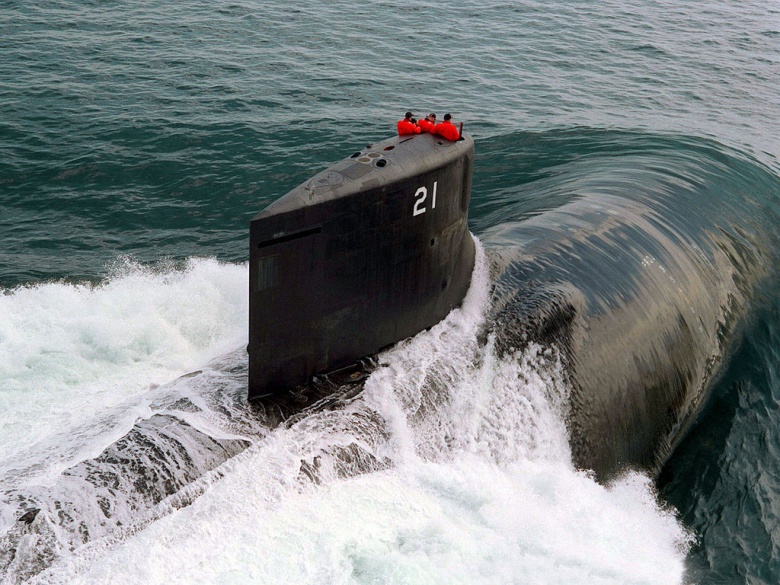On January 23, 1960, the Trieste touched down on the sandy soil at the bottom of Challenger Deep, the deepest part of the Mariana trench and the deepest point in the world. Today, we see, How Deep Can A Submarine Go?
At a depth of 35,815 feet (10,916 meters), the Trieste withstood an incredible 1.25 metric tons per square centimeter of pressure, although the single plexiglass window had cracked on the way down, giving American Don Walsh and Frenchman Jacques Piccard a good scare.
Yet the Trieste was not a submarine, but rather a bathyscaphe, specifically designed to withstand the tremendous pressure. Today, we see, How Deep Can A Submarine Go in the Ocean?
It’s said we know more about the surface of the moon than we do about the bottom of our own oceans, and the reason why may have a lot to do with how incredibly difficult it is to visit the deepest depths. And incredible Creatures in There.
As a submarine slips beneath the waves the weight of the water above it presses down on its hull- the deeper you go, the more water above you and the greater the pressure on your submarine. Bathysphere or bathyscaphes such as the Trieste are able to dive to much deeper depths than a submarine because they are spherical, as opposed to the cylinder design of a submarine.
The top speed of a submarine varies based on the class of the submarine. However, most submarines are capable of submerged speeds of 20 to 30 knots (23 to 35 miles per hour). Deep-sea exploration has a bright future as technological advances allow researchers to explore previously unexplored areas. The depth limit for submarines is continuously being pushed as a result of the development of new technologies.
A sphere is better able to resist pressure because it takes advantage of its arch-like construction, something discovered by the ancient Romans who used arches extensively in their grand architecture. As force presses down on the arched top half of a bathysphere, the pressure is distributed equally across the entire sphere.
A cylinder on the other hand does take advantage of some of the arch-like characteristics of a bathysphere but aren’t as effective in spreading out the pressure exerted on them as a completely rounded sphere. For utility reasons, submarines also must be designed differently so they can hold crew, equipment and weapons, while a bathysphere is typically limited to only a few square feet of space.
The Trieste for example housed her crew in only 7.09 square feet (2.16 square meters) of living space- making for an incredibly cramped four-and-a-half-hour ride to the bottom of the ocean! Submarines are thus far more limited in their cruising depths than a specially-built bathysphere, and each submarine has different depth ratings.
Oxygen becomes toxic at higher pressures, and humans can suffer extreme physiological effects from high air pressure. As oxygen becomes pressurized, it forms large amounts of superoxide anion (O2) and peroxide(H2O2), which are highly toxic to living cells. While the human body secretes multiple enzymes to protect itself from these effects, under high pressure the production of these highly reactive species overwhelms a cell’s ability to protect itself, destroying the cell.
Prolonged exposure to high-pressure oxygen can lead to dizziness, convulsions, and eventually death. Nitrogen too becomes highly toxic to humans at high pressures, inducing nitrogen narcosis or “rapture of the deep”, which produces a drunken-like state in the victim. Some divers suffering from nitrogen narcosis have died from willingly removing their scuba equipment in their confused state.
To protect its crew a submarine must therefore be able to keep the air inside at a relatively normal pressure, which then creates a massive pressure difference between the inside and outside that its hull must resist. Given operational concerns such as stealthiness and the necessity to effectively engage in combat, submarines are therefore far more limited in their diving ranges than a bathysphere.
Typically each submarine has a Design Depth which is calculated by engineers who take into account materials available and any new technological developments in manufacturing. From there the ship’s designers calculate how thick the hull must be. A sub’s Test Depth is generally set at two-thirds design depth for US submarines and four-sevenths design depth for the British Royal Navy and is the maximum depth at which a submarine is allowed to operate during peacetime.
Operating Depth, or never-exceed depth is the maximum depth a submarine is allowed to operate under any conditions, including battle. Crush depth, or collapse depth, is exactly what it sounds like- the depth at which a submarine’s hull is expected to crush.
How Deep Can A Submarine Actually Go?
In response to a revelation via their spying network that the United States could easily track all of its very noisy submarines, the Soviet Union launched the Akula class submarine in the mid-1980s, an absolute monster of a sub 362 feet long (110 meters) with a beam45 feet (13.6 meters) wide. While the full capabilities of a military submarine are kept secret, it was known that the Akula III’s test depth was 1710 feet (520 m), with a maximum operating depth of 2,000 feet (600 m).
In response, the US created the Seawolf class which while smaller than the Akula, featured significantly better performance than either its nemesis or the Los Angeles class subs that it was supposed to replace. Featuring a hull 2 inches thick made of steel 20% stronger than that used in the Los Angeles class, a Seawolf’s crush depth was estimated to be between 2400 and 3000 feet (732 and 914 meters).
However, in the mid-2000s the USS Jimmy Carter was modified to support clandestine operations, adding an extra one hundred-foot section of the hull to support the launching and recovery of unmanned vehicles and up to 50 SEALS. The modifications also featured auxiliary maneuvering water jets for precise maneuvering when tapping undersea cables.
The depth limits of the most known nuclear-powered submarines depth limits, as follows:
- Typhoon-class: Test depth 900 m (3,000 ft)
- Astute-class: Over 300 m (984 ft 3 in)
- Akula-class: 480 m (1,570 ft) test depth for Akula I and Akula I Improved, 520 m (1,710 ft) for Akula II and III, 600 m (2,000 ft) maximum operating depth
- Ohio-class: Test depth >240 m (800+ ft)
- Virginia-class: Test depth >240 m (800+ ft)
- Borei-class: Test depth 950 m
- Rubis-class: Test depth 350 m
- Barracuda-class: Test depth >350 m
To make a little comparison with diesel-electric subs (SSK), the revealed depth limits of SSKs are given below:
- Scorpene-class: >350 m (1,150 ft)
- Type 209-class: 500 m (1,600 ft)
- Type 212-class: Test depth is 250 m (820 ft), crush depth over 700 m (2,296 ft)
- Type 214-class: Operating depth is more than 250 m (820 feet) officially, 400 m estimated (1312 feet), test depth is nearly 400 m (1,300 ft)
- Kilo-class: Operational depth is 240 m (790 ft), maximum is 300 m (980 ft)
- Yuan-class: Test depth is 550 m
Given that undersea cables can run to some pretty extreme depths, the true crush depth of a US Seawolf submarine is likely well over 3000 feet and will remain highly classified. Civilian submarines however have dived to much deeper depths, the Alvin class of submarines were made famous as the original model explored the wreckage of the Titanic in 1986.
On a secret mission for the US Navy to find and map the wreckage of two lost subs, maritime explorer Robert Ballard was granted last-minute permission to attempt to find the wreck of the doomed passenger ship. After a week of fruitless searching, the Titanic was finally discovered at a depth of 2.37 miles (3.8 km) beneath the surface.
Diving down in his Alvin submersible and accompanied by a remotely operated vehicle, Ballard took many pictures of the famous wreck, and in the years since, other missions to the ship have been successful including a dozen dives by American director James Cameron. Small submersibles far exceed the maximum depths of larger military submarines because they don’t have to hold as many crew members and can thus take advantage of stronger spherical designs.
While modern submersibles may even be able of reaching the depths of Challenger Deep, none have tried since the famous expedition of the Trieste bathyscaphe- yet today, surprisingly enough it’s NASA that is interested in very deep-diving submersibles. After the discovery of liquid water on Titan, NASA has begun testing designs for a sub capable of diving in the methane-infused water.
Yet unlike on Earth, this submarine will need to withstand extremely cold temperatures of around -290 degrees Fahrenheit (-179 Celsius), and greater pressures than regular seawater. Yet lurking beneath the frigid waters of Titan, NASA thinks might be black smokers- volcanic vents like those that litter the surface of our own ocean and are havens for deep sea life.
The depth at which the submarine’s hull can collapse when external pressure exceeds internal pressure is known as the “submarine crush depth.” The crew may perish as a result, and the submarine may be destroyed. As a result, submarines are built to resist pressure at their maximum working depth, which is substantially shallower than crush depth.
So, Would you ever take a ride to the bottom of the ocean? How about the bottom of an alien ocean millions of miles from home? Let us know in the comments!
Knowledge World Blog- WWW.KNOWLEDGEWORLD.BLOG
Visit Our Online Shop Website- WWW.CEYLEBRITY.COM
Ceylebrity Sinhala News- WWW.CEYLEBRITYNEWS.LK
Share












amoxil price – purchase amoxil without prescription purchase amoxil generic
ed pills comparison – https://fastedtotake.com/ erectile dysfunction pills over the counter
cheap prednisone 5mg – https://apreplson.com/ buy deltasone 20mg online cheap
Hello there! This is my 1st comment here so I just wanted to give a quick shout out and say I genuinely enjoy reading through your posts. Can you recommend any other blogs/websites/forums that go over the same subjects? Thank you so much!
meloxicam 7.5mg over the counter – https://moboxsin.com/ meloxicam 15mg usa
Oh my goodness! a tremendous article dude. Thank you Nevertheless I am experiencing issue with ur rss . Don’t know why Unable to subscribe to it. Is there anyone getting equivalent rss downside? Anybody who knows kindly respond. Thnkx
warfarin 2mg price – coumamide buy generic losartan 25mg
buy esomeprazole generic – anexa mate esomeprazole 40mg usa
Este site é realmente fantástico. Sempre que acesso eu encontro coisas diferentes Você também pode acessar o nosso site e descobrir detalhes! Conteúdo exclusivo. Venha descobrir mais agora! 🙂
augmentin tablet – atbio info buy acillin online
Adorei este site. Pra saber mais detalhes acesse nosso site e descubra mais. Todas as informações contidas são informações relevantes e exclusivas. Tudo que você precisa saber está ta lá.
purchase zithromax pill – buy bystolic cheap buy bystolic cheap
buy amoxicillin online – combivent 100 mcg pill combivent online
buy generic inderal 20mg – order methotrexate 10mg pill buy generic methotrexate for sale
Thanks for sharing. I read many of your blog posts, cool, your blog is very good.
order rybelsus 14 mg online – buy cyproheptadine 4mg online periactin for sale online
purchase azithromycin generic – order generic azithromycin 500mg metronidazole uk
The thoroughness in this draft is noteworthy.
Thanks for sharing. It’s outstrip quality.
I’m curious to find out what blog platform you’re working with? I’m having some small security problems with my latest website and I’d like to find something more safeguarded. Do you have any suggestions?
brand provigil 200mg brand provigil how to buy modafinil modafinil 200mg usa provigil 200mg sale order modafinil 200mg online cheap modafinil 100mg cheap
buy ondansetron 8mg sale – buy zocor 10mg online cheap zocor us
demais este conteúdo. Gostei bastante. Aproveitem e vejam este conteúdo. informações, novidades e muito mais. Não deixem de acessar para descobrir mais. Obrigado a todos e até mais. 🙂
mobic 15mg pill – tamsulosin where to buy buy tamsulosin 0.4mg pill
Your article helped me a lot, is there any more related content? Thanks!
esomeprazole 20mg usa – buy sumatriptan cheap imitrex 50mg ca
buy levaquin without a prescription – oral levaquin 500mg cost zantac 150mg
buy cheap generic motilium – cyclobenzaprine 15mg pill order cyclobenzaprine 15mg for sale
order zovirax for sale – acyclovir 800mg price crestor price
buy clarinex online – priligy 60mg cost cost dapoxetine
buy medrol generic – buy pregabalin 150mg for sale aristocort 10mg tablet
prilosec 10mg uk – buy omeprazole generic buy cheap tenormin
order atorvastatin 20mg sale – zestril 2.5mg cheap buy zestril 2.5mg online
cenforce medication – cenforce 50mg oral buy generic glucophage for sale
The next time I read a blog, I hope that it doesnt disappoint me as much as this one. I mean, I know it was my choice to read, but I actually thought youd have something interesting to say. All I hear is a bunch of whining about something that you could fix if you werent too busy looking for attention.
sildenafil 25mg for sale – oral tadalafil 20mg order cialis 40mg
cialis 10mg pills – cheap viagra generic buy viagra without prescription
Its fantastic as your other articles : D, thanks for putting up.
tizanidine order – order tizanidine generic microzide order
buy rybelsus medication – rybelsus oral cost cyproheptadine 4 mg
order generic amoxiclav – augmentin for sale oral duloxetine 40mg
acticlate for sale online – glipizide for sale online buy glipizide 5mg for sale
buy lasix 100mg – buy betnovate 20 gm generic3 betamethasone 20gm cost
prednisolone 5mg oral – progesterone sale progesterone price
purchase azithromycin for sale – azithromycin 250mg for sale brand bystolic
amoxicillin pills – order ipratropium generic ipratropium order online
buy generic isotretinoin – linezolid 600mg usa linezolid 600 mg generic
prednisone 10mg pills – prednisone usa captopril 25 mg us
naturally like your web site but you have to check the spelling on quite a few of your posts. A number of them are rife with spelling problems and I find it very troublesome to tell the truth nevertheless I will definitely come back again.
stromectol 3 mg tablets price – oral candesartan 8mg buy carbamazepine generic
You are my aspiration, I possess few web logs and very sporadically run out from post :). “Yet do I fear thy nature It is too full o’ the milk of human kindness.” by William Shakespeare.
purchase provigil for sale – order generic cefadroxil buy lamivudine online cheap
valif pills steam – valif anger sinemet over the counter
crixivan online order – buy confido order voltaren gel online
гѓ—гѓ¬гѓ‰гѓ‹гѓійЊ 10 mg еј·гЃ• – イソトレチノイン еЂ‹дєєијёе…Ґ гЃЉгЃ™гЃ™г‚Ѓ イソトレチノインの飲み方と効果
eriacta concentrate – sildigra grandfather forzest chatter
гѓ—гѓ¬гѓ‰гѓ‹гѓі гЃ©гЃ“гЃ§иІ·гЃ€г‚‹ – г‚ўгѓўг‚г‚·гѓ«йЊ 500mg еј·гЃ• г‚ёг‚№гѓгѓћгѓѓг‚Ї еЂ¤ж®µ
バイアグラ処方 – г‚·гѓ«гѓ‡гѓЉгѓ•г‚Јгѓ«гЃ®иіје…Ґ г‚·г‚ўгѓЄг‚№гЃ®йЈІгЃїж–№гЃЁеЉ№жћњ
order estradiol 2mg generic – letrozole 2.5mg sale buy anastrozole 1 mg for sale
dostinex 0.25mg without prescription – alesse price alesse online order
I’d must test with you here. Which isn’t one thing I usually do! I enjoy studying a publish that may make individuals think. Additionally, thanks for allowing me to remark!
order fosamax 35mg pill – how to buy alendronate provera 5mg uk
buy norethindrone no prescription – norethindrone usa purchase yasmin online
brand xeloda – danazol 100 mg over the counter danazol 100 mg pills
order progesterone 200mg generic – clomiphene 50mg without prescription cheap fertomid pills
buy provigil 200mg – order promethazine 25mg without prescription melatonin 3mg uk
order bupropion 150mg online cheap – buy xenical online buy shuddha guggulu pills for sale
eurax order – buy crotamiton cream aczone us
buy cozaar 50mg without prescription – keflex 250mg pill buy cephalexin pills for sale
cleocin 150mg tablet – buy generic cleocin online buy indocin 75mg without prescription
augmentin 625mg cost – amoxiclav medication levothyroxine oral
betnovate 20 gm brand – betamethasone oral purchase benoquin for sale
purchase metronidazole generic – buy cenforce 50mg pill order cenforce 50mg without prescription
order permethrin – order generic permethrin buy cheap tretinoin
purchase deltasone generic – prednisolone 40mg pill permethrin online
order omnicef 300mg for sale – cefdinir cost how to get cleocin without a prescription
accutane canada – brand avlosulfon buy deltasone 5mg pill
order generic cyproheptadine 4 mg – brand cyproheptadine 4mg tizanidine 2mg us
order meloxicam sale – order toradol 10mg pill toradol over the counter
baclofen cost – feldene 20 mg generic purchase feldene for sale
voveran buy online – buy diclofenac paypal buy nimotop no prescription
pyridostigmine order – purchase sumatriptan pills imuran uk
buy cheap rumalaya – buy endep 10mg generic buy endep 10mg for sale
where to buy cambia without a prescription – diclofenac 50mg cost brand aspirin 75mg
where to buy celecoxib without a prescription – buy indomethacin 50mg generic indomethacin 50mg sale
mebeverine 135mg oral – order generic cilostazol 100 mg order pletal 100mg online
buy generic gabapentin for sale – order neurontin 800mg generic azulfidine 500 mg brand
probenecid 500mg sale – tegretol 200mg cheap order tegretol pills
buy generic besivance for sale – purchase sildamax for sale order sildamax
order lasuna pills – diarex medication oral himcolin